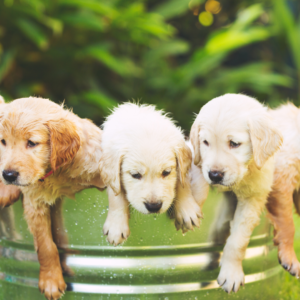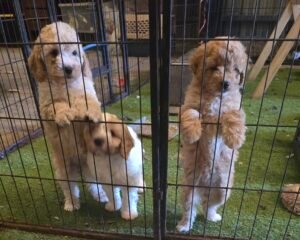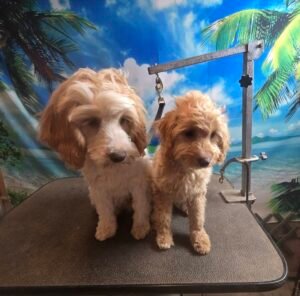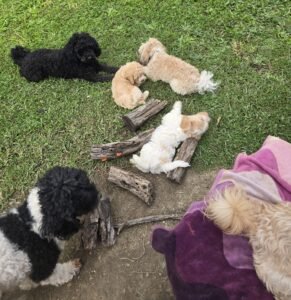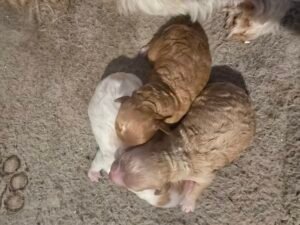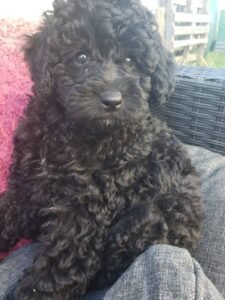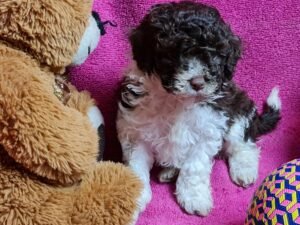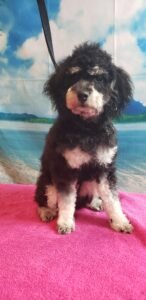There are over 800 pedigree dog breeds recognized today in the world. Modern dog evolution is obscure. They are believed to have split from wild wolves into a subspecies about 100,000 years ago and then domesticated 17,000 to 14,000 years ago, probably in China or in multiple places from Europe to Asia. .Dogs can still interbreed with wolves in a genetic process know as introgression. Early dog fossils were found in Russia and Germany from the large northern Holartic wolf, 17,000 to 14,000 years ago. Remains of smaller dogs, descendant from a lighter Southwest Asian wolf were found in Middle East cave deposits around 12, 000 years ago.
Humans emigrated from Asia and Europe and domesticated dogs went with them. The agricultural revolution and then the urban revolution led to an increase in dog numbers. Selective breeding, using artificial selection, resulted in the specialization of dogs into working dogs and pets over hundreds of years.
All modern breeds are relatively recent in this long time line of history. The four most common small breeds in Australia are the Cavoodle, Shih Tzu, Maltese, Poodle and Cavalier King Charles Spaniel.
The Shih Tzu’s origination is unclear; they were first seen in the imperial palace in Beijing when French and English troops attacked the summer palace during the second Opium War (1856-1860), forcing the Empress Dowager Tzutsi to flee with her dogs. Developed exclusively as a companion lap dog they remained obscure, not arriving in the United States until the 1930’s and only gaining breed recognition in 1952
The Poodle possibly originated in Eastern Germany with influence from Russia and was standardized as the French national dog. German Poodles (from the German word pudel – “to splash in water”) were sturdy dogs with curly and corded coats. The corded coat, rarely seen in the United States, still exists. The Russian variety was somewhat “greyhound” in body type.
Clipped poodles were seen in fifteenth, sixteenth and seventeenth century manuscripts and paintings. The standard poodle was originally used to retrieve game from water, hence the unusual hind clipping. The smaller dogs were circus trick and stunt dogs, truffle dogs and companions. The first poodle in England (1635) belonging to Prince Rupert of the Palatinate but it died in the Battle of Marston Moor in 1644. The next poodles were not recorded in Great Britain until 1874 and America in 1886.
The Maltese, in existence for at least 3,000 years, originated either from the island of Malta or a town in Sicily named Melita. The Phoenicians (1500 B.C) had a small white Maltese dog in their culture. Publius (100 AD), Rome’s Governor of Malta, owned “Issa”: a Maltese who meant more to him than any other living thing. Ancient Egyptians and Eastern Potentates kept Maltese for the ladies in the Harems. Renaissance ladies carried Maltese in their sleeves and they were eagerly accepted by the British aristocracy from the time of Queen Elizabeth and are immortalized in literature by famous artists. Maltese dogs have been bred and exhibited in Australia for the last 50-70 years
Cavalier King Charles Spaniels, direct descendant of small Toy Spaniels, were seen in many 16th, 17th and 18th century pictures. Common as Tudor Court ladies’ pets they were officially renamed Cavalier King Charles under the reign of the Stuarts. King Charles II was seldom seen without two, three or more at his heels. In Queen Victoria’s reign breeders started to hold shows and bred to a desired type. In 1928, the breed standard was drawn up and today is basically unchanged. In 1945 the British Kennel Club granted separate registration, the first dogs were introduced into America in 1952 but did not gain full breed recognition for 40 years.
These popular breeds have hundreds of years of careful selective breeding to specific standards to ensure correct temperament, type and health. Each country using a defined standard that referenced world wide breed standards developed over decades by breeders with considerable training in canine anatomy, health and breeding principles.
Taking a Cavalier, Maltese or Shih Tzu and mating it to a Poodle, without either having a certified pedigree, produces cross bred dogs of no defined breed. It will always be a cross bred dog, despite how lovely a dog it is. It does not carry the years of selective breeding history for type, temperament and health as seen in pure-bred, pedigree dogs. If the parents were pedigree dogs then the resulting dog is called a hybrid but is still not a pure dog breed.
The American Kennel Club (AKC), recognized as one of the top kennel clubs in the world, states that to recognize a new breed they require at least 300 hybrid dogs within the U.S. and distributed among at least 20 states. The dogs must have a National Breed Club and there must be at least a three generation pedigree—e.g. three generations of oodle-to-oodle mating. They must have predictable characteristics and fulfill a specific purpose. This can only be achieved with a concerted program between hundred of breeders breeding specific health checked and temperament checked animals to each other with excellent record keeping. Here in Australia Cavoodle breeders are moving toward a breed that will be know as Theodores . At this stage there doesn’t appear to be acceptance by the ANKC of this emerging breed.
A designer dog is designed for what? Hybrid vigor is the normal argument and it is clearly not seen. People who indiscriminately mate a dog of uncertain parentage to another dog of uncertain parentage have no guarantee of predictable offspring. They have no way of producing a dog that is genetically superior and free of the health problems inherent in many dogs, such as incorrect mouths, poor bone construction, epilepsy, hip dysplasia, luxating patella and heart defects. The old saying “You get what you pay for” is only too true in dog breeding. Pay more and chose a purebred with hundreds of years of selective breeding from a reputable breeder to ensure a happy, healthy puppy. However obtaining healthy puppies isn’t something that only non pure-bred breeders struggle with. Even pure bred dogs mated without the correct health checks can produce puppies not fit for sale.
http://en.wikipedia.org/wiki/Dogs
http://www.tinyshihtzu.com/origins.htm
Poodle clipping and grooming – the International Reference by Shirley Kalstone – Howell Book House 2001.
http://www.barkbytes.com/history/poodle.htm
http://www.thecavalierclub.co.uk/breed/history.html
http://www.akc.org/breeds/cavalier_king_charles_spaniel/history.cfm https://responsiblepetbreeders.com.au/theodore/


Kareema
Healing Energy Animals
Kareema is the owners of Healing Energy Animals where devil dogs, horrible horses and crazy cats are turned into perfect pets using Relationship Animal Training and over 50 years of experience training a wide variety of animals.
Healing Energy Animals provides owners and pet professionals assistance with with common pet behavior training, feeding and grooming issues such as barking, escaping, scratching, aggression and fleas. Kareema consults and writes widely on a range of pet care issues for owners and also assists pet care professionals in setting up and growing their businesses by the provision of customer handling advice, sales and marketing strategies and up to date product information that allows for the differentiation of their pet care business from their competitors.
Healing Energy Animals is an Australian business but operates worldwide via the provision of virtual services.

